
Boana is a genus of frogs in the family Hylidae. They are commonly known as gladiator frogs, gladiator treefrogs or Wagler Neotropical treefrogs. These frogs are distributed in the tropical Central and South America from Nicaragua to Argentina, as well as in the Caribbean.

The white-edged tree frog is a species of frog in the taxonomic family Hylidae endemic to Brazil.

The striped tree frog is a species of frog in the family Hylidae found in Argentina, Brazil, and Paraguay. Its natural habitats are subtropical or tropical dry forests, subtropical or tropical moist lowland forests, subtropical or tropical dry lowland grassland, subtropical or tropical seasonally wet or flooded lowland grassland, rivers, swamps, heavily degraded former forests, and ponds. It is not considered threatened by the IUCN.
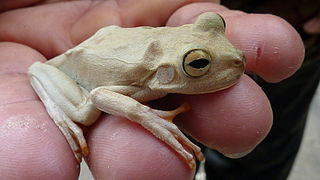
The emerald-eyed tree frog is a species of frog in the family Hylidae. It is largely restricted to the Atlantic Forest region of Brazil. Some populations previously regarded as Boana crepitans have been separated into the species Boana xerophylla and Boana platanera.

The Amapa tree frog is a species of frog in the family Hylidae found in northern Brazil in the Amapá state, French Guiana, and southeastern Suriname. It belongs to the Boana albopunctata species group.
Boana goiana is a species of frog in the family Hylidae that is endemic to Brazil. Its natural habitats are moist savanna, subtropical or tropical moist shrubland, subtropical or tropical high-altitude shrubland, and rivers. It is threatened by habitat loss, though is still currently of least concern as its conservation status.
Hobbs' tree frog is a species of frog in the family Hylidae found in Colombia, Venezuela, and possibly Brazil. Its natural habitats are subtropical or tropical moist lowland forests and rivers. It is threatened by habitat loss.

The fine-lined tree frog is a species of frog in the family Hylidae endemic to Brazil. Its natural habitats are moist savanna, rivers, freshwater marshes, and intermittent freshwater marshes.

The Usina tree frog is a species of frog in the family Hylidae endemic to Brazil. Its natural habitats are subtropical or tropical moist lowland forests, subtropical or tropical moist montane forests, moist savanna, rivers, and plantations.
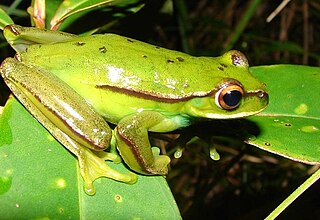
The Mundo Novo tree frog is a species of frog in the family Hylidae. It is endemic to south-eastern Brazil where it is known from the easternmost Rio Grande do Sul and adjacent southeastern Santa Catarina. Its natural habitats are forested mountain slopes near streams with clear running water. The eggs are deposited on vegetation hanging into the water. It is a common species although habitat loss and water pollution are threats.
The smallskin tree frog is a species of frog in the family Hylidae found in Brazil, Colombia, and Peru. Its natural habitats are subtropical or tropical moist lowland forests and rivers.

The many-banded tree frog is a species of frog in the family Hylidae found in Brazil, French Guiana, Guyana, Suriname, and Venezuela. Its natural habitats are subtropical or tropical dry forests, subtropical or tropical moist lowland forests, moist savanna, rivers, freshwater lakes, freshwater marshes, pastureland, rural gardens, heavily degraded former forests, and canals and ditches.

The ornate tree frog is a species of frogs in the family Hylidae found in Brazil, Colombia, French Guiana, Guyana, Suriname, and Venezuela. Its natural habitats are subtropical or tropical moist lowland forests, freshwater marshes, and intermittent freshwater marshes.

The leopard tree frog is a species of frog in the family Hylidae endemic to Brazil. Its natural habitats are subtropical or tropical dry forests, subtropical or tropical moist lowland forests, subtropical or tropical moist montane forests, freshwater marshes, intermittent freshwater marshes, plantations, rural gardens, heavily degraded former forests, ponds, and canals and ditches.
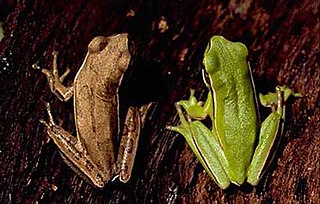
The Montevideo tree frog is a species of frog in the family Hylidae found in eastern, central, and northern Argentina, south-eastern Brazil, south-eastern Paraguay, and Uruguay. It is a common species occurring in open habitats in forests, grasslands, and flooded savannas. Breeding takes place in permanent ponds and flooded grasslands.
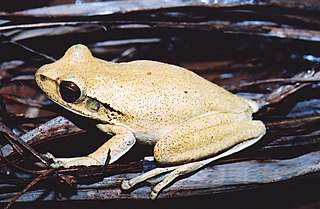
The Chaco tree frog is a frog species in the family Hylidae found in Argentina, Bolivia, Brazil, Colombia, French Guiana, Paraguay, and Venezuela.
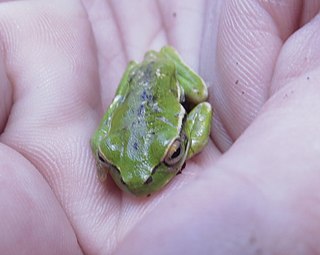
Boana riojana is a species of frog in the family Hylidae. It is found in the eastern Andes and the Andean foothills between La Rioja Province in Argentina and northern Bolivia, and possibly further into adjacent Peru. Common name Carrizo's tree frog has been used when referring to the formerly recognized Boana varelae(Carrizo, 1992).
The Barro Branco tree frog is a species of frog in the family Hylidae endemic to Brazil. Its natural habitats are subtropical or tropical moist lowland forests, rivers, freshwater marshes, and intermittent freshwater marshes.
Boana stenocephala is a species of frog in the family Hylidae that is endemic to Brazil. Its natural habitats are moist savanna and rivers. It is threatened by habitat loss.
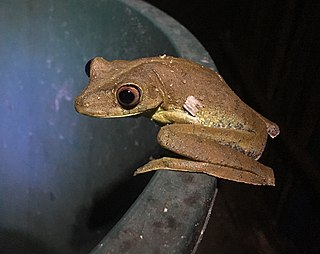
The Upper Orinoco tree frog is a species of frog in the family Hylidae found in Brazil, Colombia, and Venezuela, and possibly Bolivia and Guyana. Its natural habitats are subtropical or tropical moist lowland forests, subtropical or tropical swamps, moist savanna, and rivers. It is threatened by habitat loss.
















